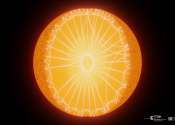Scientists on the hunt for evidence of quantum gravity's existence at the South Pole
Several thousand sensors distributed over a square kilometer near the South Pole are tasked with answering one of the large outstanding questions in physics: does quantum gravity exist? The sensors monitor neutrinos—particles ...









